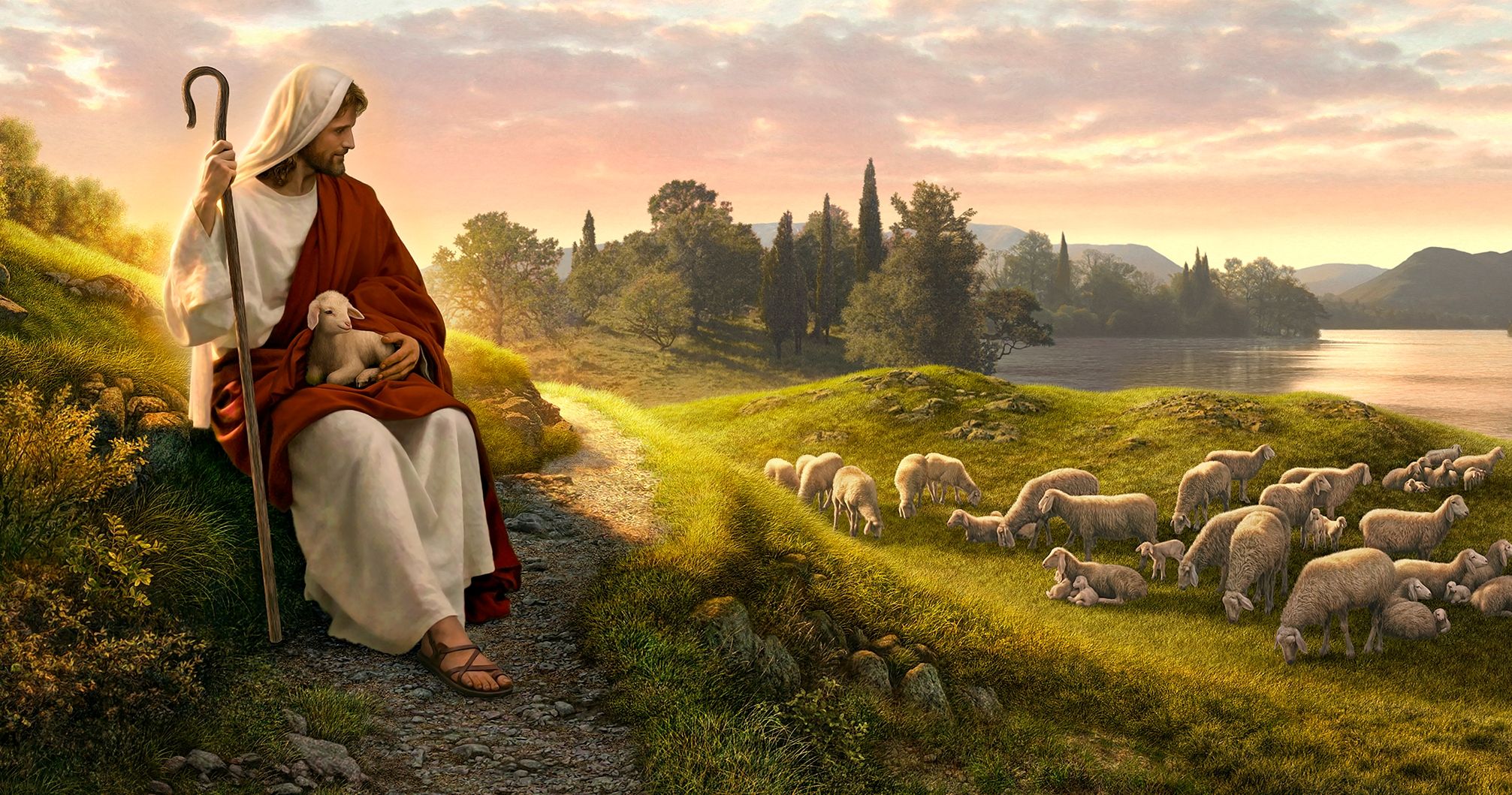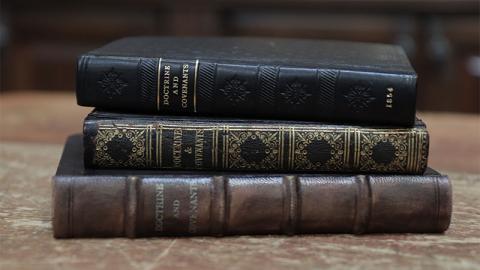You are here
Book of Mormon Central is in the process of migrating to our new Scripture Central website.
We ask for your patience during this transition. Over the coming weeks, all pages of bookofmormoncentral.org will be redirected to their corresponding page on scripturecentral.org, resulting in minimal disruption.

D&C 71–75
New from BMC
Watch videos from Gospel scholars and teachers to learn more about these sections of the Doctrine and Covenants. Book of Mormon Central produces weekly videos from Tyler Griffin, Taylor Halverson, John Hilton III, Anthony Sweat, Casey Griffiths, Stephanie Dibb Sorensen and Marianna Richardson. Read commentaries and other resources from KnoWhys, Steven C. Harper, Casey Griffiths, and Susan Easton Black.
Overview
Doctrine and Covenants 71
Doctrine and Covenants 72
Doctrine and Covenants 73
Doctrine and Covenants 74
Doctrine and Covenants 75
Daily Reading Plan
Structure your personal scripture study by following a 15-minute, day-by-day plan. Each day's assignment includes the required scripture passages from the Come, Follow Me curriculum, as well as suggestions for additional resources to bring context and understanding to your study. For the best experience, use our Reading Plan in the free ScripturePlus app! You can track your progress and have access to the best resources.
Monday
- Commentary 12071: Section 71, 73 Context, Steven C. Harper
- Scripture: D&C 71:1–11
- Commentary 50712: Casey Paul Griffiths, Doctrine and Covenants Minute, Doctrine and Covenants 71:1–4
- Commentary 50713: Casey Paul Griffiths, Doctrine and Covenants Minute, Doctrine and Covenants 71:5–11
Tuesday
- Commentary 12072: Section 72 Context, Steven C. Harper
- Scripture: D&C 72:1–15
- Commentary 50715: Casey Paul Griffiths, Doctrine and Covenants Minute, Doctrine and Covenants 72:1–8
- Commentary 50716: Casey Paul Griffiths, Doctrine and Covenants Minute, Doctrine and Covenants 72:9–15
Wednesday
- Scripture: D&C 72:16–26
- Commentary 50717: Casey Paul Griffiths, Doctrine and Covenants Minute, Doctrine and Covenants 72:16–26
- Video:
Thursday
- Scripture: D&C 73:1–6
- Commentary 12074: Section 74 Context, Steven C. Harper
- Scripture: D&C 74:1–7
-
Quote 3006: The power of tradition, however, poses a significant danger. It can cause us to forget our heavenly heritage. To achieve eternal goals, we must reconcile our earthly culture with the doctrine of the everlasting gospel. This process involves embracing all that is spiritually elevating in our family and societal traditions and discarding that which is a barrier to our eternal view and achievement. We must transform ourselves from being “natural” men and women as defined by King Benjamin, and “becometh a saint” by yielding “to the enticings of the Holy Spirit.”
Also warning of this peril and its gravity, the Prophet Joseph Smith was inspired to clarify one of Paul’s epistles to the people of Corinth by stating, “And it came to pass that the children, being brought up in subjection to the law of Moses, gave heed to the traditions of their fathers and believed not the gospel of Christ, wherein they became unholy” (D&C 74:4).
Please be not dismissive and think this principle applies only to others and their culture; know that it is valid for you and for me, wherever on earth we may live or whatever our family circumstances may be.
Unwanted traditions are those which lead us away from performing holy ordinances and keeping sacred covenants. Our guide should be the doctrine taught by the scriptures and the prophets. Traditions which devalue marriage and family, abase women or do not recognize the majesty of their God-given roles, honor temporal success more than spiritual, or teach that reliance upon God is a weakness of character, all lead us away from eternal truths.
Of all the traditions we should cultivate within ourselves and our families, a “tradition of righteousness” should be preeminent. Hallmarks of this tradition are an unwavering love for God and His Only Begotten Son, respect for prophets and priesthood power, a constant seeking of the Holy Spirit, and the discipline of discipleship which transforms believing into doing. A tradition of righteousness sets a pattern for living which draws children closer to parents, and both closer to God, and elevates obedience from a burden to a blessing.
Donald L. Hallstrom, “Cultivate Righteous Traditions,” October 2000 General Conference. -
Quote 3007: Elder Christofferson taught: “It should be remembered that not every statement made by a Church leader, past or present, necessarily constitutes doctrine. It is commonly understood in the Church that a statement made by one leader on a single occasion often represents a personal, though well-considered, opinion, not meant to be official or binding for the whole Church.”
In the following conference, Elder Andersen taught this principle: “The doctrine is taught by all 15 members of the First Presidency and Quorum of the Twelve. It is not hidden in an obscure paragraph of one talk.” The family proclamation, signed by all 15 prophets, seers, and revelators, is a wonderful illustration of that principle.
Dallin H. Oaks, “Trust in the Lord,” October 2019 General Conference.
Friday
- Commentary 12075: Section 75 Context, Steven C. Harper
- Scripture: D&C 75:1–12
-
Commentary 50724: These scriptures reiterate that it is important to labor diligently to preach the gospel; they further emphasize the importance of “proclaiming the truth according to the revelations and commandments which I have given unto you” (D&C 75:4). Such stress on the commandments and revelations given in our time highlights the importance of sharing what is unique about our message. There is much to be gained from building on common beliefs with other faiths, but we also need to emphasize why we are different from those of other faiths.
One key difference between our faith and other faiths is the Restoration of the gospel of Jesus Christ. During a meeting held in Philadelphia, Pennsylvania, in January 1840, Parley P. Pratt recorded an experience that underlines the importance of emphasizing the Restoration in our teaching. According to Elder Pratt,
A very large church was opened for him [Joseph Smith] to preach in, and about three thousand people assembled to hear him. Brother Rigdon spoke first, and dwelt on the Gospel, illustrating his doctrine by the Bible. When he was through, Brother Joseph arose like a lion about to roar; and being full of the Holy Ghost, spoke in great power, bearing testimony of the visions he had seen, the ministering of angels which he had enjoyed; and how he had found the plates of the Book of Mormon, and translated them by the gift and power of God. He commenced by saying: “If nobody else had the courage to testify of so glorious a message from Heaven, and of the finding of so glorious a record, he felt to do it in justice to the people, and leave the event with God.”
Elder Pratt added, “The entire congregation were astounded; electrified, as it were, and overwhelmed with the sense of the truth and power by which he spoke, and the wonders which he related. A lasting impression was made; many souls were gathered into the fold.”
As illustrated in the way Joseph Smith taught the congregation in Philadelphia, we have an obligation to bear witness of the Restoration of Christ’s gospel. Outreach and understanding to other faiths will always be an important part of our work, but we also have a solemn charge to proclaim the Restoration of the gospel of Jesus Christ in the latter days through the Prophet Joseph Smith.
Casey Paul Griffiths, Doctrine and Covenants Minute, Doctrine and Covenants 75:1–5 -
Commentary 50725: The second part of this revelation is directed toward William E. McLellin, who had previously been called to serve a mission with Samuel Smith (D&C 68:7–8). The pair left to preach in eastern Ohio on November 16, 1831. On December 15, McLellin fell ill with a violent cold that confined him to bed. The elders’ mission was cut short, and McLellin returned to Hiram, Ohio, on December 29, just forty-four days after his mission began. When Samuel Smith wrote about this brief term in the mission field, he commented, “We went a short distance, but because of disobedience, our way was hedged up before us.” Samuel never elaborated on what the nature of the disobedience was, but in this revelation, McLellin was rebuked for “the murmurings of his heart” (D&C 75:7). He was then assigned to a new field of labor with Luke Johnson instead of with Samuel Smith.
Brother McLellin was not cut off from the Lord because of his disobedience or illness. In fact, during the time between returning from his first mission and receiving this revelation, he had an extraordinary experience. Years after this time, Brother McLellin told Orson Pratt that on January 18, 1832, about a week before Doctrine and Covenants section 75 was given, he found himself alone with Joseph Smith in the translating room of the Johnson home. William asked Joseph to inquire of the Lord regarding an important matter. Joseph replied, “Do you inquire of God [?] . . . I will pray for you that you may obtain.” William complied with the Prophet’s instructions, later recalling: “I did receive and I wrote it. And when I read it to him [Joseph Smith] he shed tears of joy and said to me, ‘Brother William, that is the mind of the will of God, and as much a revelation as I ever received in my life. You have written it by the spirit of inspiration.’” William later reflected,
I was never vain enough to suppose that “I was planted in Joseph’s stead,” nor that it was my duty or privilege to receive by revelation laws or regulations for the whole church. I knew better. But at that time I saw, heard, and felt what I wrote. There and then I learned a principle, and was put in possession of a power that I shall never forget. I learned to know the voice of the Spirit of God clothed in words. And if I had heeded its voice from that day to this, I should have missed many—very many difficulties through which I have passed.
Serving as a coda to William’s earlier experience when he was challenged by the Lord to write scripture but failed, this episode shows the tender mercy of the Lord toward his children. Even a troubled soul like William McLellin was inspired to learn that the Lord knew him and his desires (See commentary for D&C 67).
Casey Paul Griffiths, Doctrine and Covenants Minute, Doctrine and Covenants 75:6–12
Saturday
- Scripture: D&C 75:13–22
-
Commentary 50726: In these commandments to various elders, the Lord again emphasizes the elders’ different roles in acting as judges of the people and instructs them to shake the dust off their feet as a testimony against those who reject them (D&C 24:15–16). Along with this, He also instructs the elders to bless the homes that they enter. Those commissioned by the Church have an obligation to both teach, judge, and bless the homes they visit.
An experience shared by William F. Cahoon illustrates how these duties are carried out. When he was just seventeen years old, Cahoon was called as a teacher and asked to visit the homes of the Saints. The family of Joseph Smith was among those he was asked to visit. After receiving this young man warmly into his home, Joseph said, “Brother William, I submit myself and my family into your hands . . . ask all the questions you feel like.” William later recalled, “By this time my fears and trembling had ceased and I said, ‘Brother Joseph are you trying to live your religion?’ He answered ‘Yes.’ I then said ‘Do you pray in your family?’ He said ‘Yes.’ ‘Do you teach your family the principles of the gospel?’ He replied ‘Yes, I am trying to do it.’ ‘Do you ask a blessing on your food?’ He answered ‘Yes.’ ‘Are you trying to live in peace and harmony with all your family?’ He said that he was.”
William then turned to Emma Smith and said “‘Sister Emma, are you trying to live your religion? Do you teach your children to obey their parents? Do you try to teach them to pray?’ To all these questions she answered ‘Yes, I am trying to do so.’ I then turned to Joseph and said, ‘I am now through with my questions as a teacher; and now if you have any instructions to give, I shall be happy to receive them.’ He said ‘God bless you, Brother William; and if you are humble and faithful, you shall have power to settle all difficulties that may come before you in the capacity of a teacher.’ I then left my parting blessing upon him and his family, as a teacher, and took my departure.”
Casey Paul Griffiths, Doctrine and Covenants Minute, Doctrine and Covenants 75:13–22 - Video
Sunday
- Scripture: D&C 75:23–36
-
Commentary 50727: In the final instructions given to this group of elders, the Lord directs the elders to ensure their families are taken care of before they depart on their missions. The Lord teaches that “every man is obliged to provide for his own family” (D&C 75:28). Both ancient and modern prophets have taught that fathers must fulfill their duties to “provide the necessities of life and protection for their families.” Paul, writing to Timothy, declared, “But if any provide not for his own, and specially for those of his own house, he hath denied the faith, and is worse than an infidel” (1 Timothy 5:8).
In our time, Elder D. Todd Christofferson has taught that “breadwinning is a consecrated activity.” He added, “Providing for one’s family, although it generally requires time away from the family, is not inconsistent with fatherhood—it is the essence of being a good father. ‘Work and family are overlapping domains.’ This, of course, does not justify a man who neglects his family for his career or, at the other extreme, one who will not exert himself and is content to shift his responsibility to others.”
Casey Paul Griffiths, Doctrine and Covenants Minute, Doctrine and Covenants 75:23–36 -
Quote 3010: In authorizing assistance, the bishop, as common judge, has the further responsibility to determine the work or services to be performed by the recipients. This provides them the privilege of maintaining their dignity and self-respect, while sharing in the process of generating the resources they and others will use. Bishops must be ever watchful on this point of work by recipients for what they receive. We must never let the Lord’s program of self-help become a dole, for “the idler shall not have place in the church, except he repent and mend his ways” (D&C 75:29). If an individual refuses to do his part by working according to his ability, then the bishop has the prerogative of withholding assistance until a reformation of attitude is achieved.
Marion G. Romney, “The Role of a Bishop in the Church Welfare Program,” October 1979 General Conference. -
Quote 3011: In 1832 Martin Harris’s older brother, Emer, who is my great-great-grandfather, was called on a mission from Ohio (see D&C 75:30). Emer spent a year preaching the gospel near his former home in northeastern Pennsylvania. During most of this time Emer’s companion was his brother Martin, whose zeal in preaching even caused him to be jailed for a few days. The Harris brothers baptized about 100 persons. Among those baptized was a family named Oaks, which included my great-great-grandfather. Thus, my middle name and my last name come from the grandfathers who met in that missionary encounter in Susquehanna County in 1832–33.
Dallin H. Oaks, “The Witness: Martin Harris,” April 1999 General Conference.
Bibliography
Doctrine and Covenants 71
Steven C. Harper, “Section 71, 73,” Doctrine and Covenants Contexts (Springville, UT: Book of Mormon Central, 2021), 168–171.
Susan Easton Black, “Proclaim My Gospel - Insight Into D&C 71,” Restoration Voices Volume 2: Insights and Stories of the Doctrine and Covenants (Springville, UT: Book of Mormon Central, 2021).
Matthew McBride, “Ezra Booth and Isaac Morley,” Revelations in Context: The Stories Behind the Sections of the Doctrine and Covenants. Salt Lake City, UT: The Church of Jesus Christ of Latter-day Saints, 2016.
Susan Easton Black, “Ezra Booth,” Restoration Voices Volume 1: People of the Doctrine and Covenants (Springville, UT: Book of Mormon Central, 2021).
Robert J. Matthews, “The Joseph Smith Translation: A Primary Source for the Doctrine and Covenants,” in Sperry Symposium Classics: The Doctrine and Covenants, ed. Craig K. Manscill (Provo, UT: Religious Studies Center, Brigham Young University, 2004), 142–154.
D&C 71:9
Book of Mormon Central, “How Can We Know What to Believe about Joseph Smith’s Personal Character? (3 Nephi 8:1) KnoWhy 413 (March 6, 2018).
Sharon Anderson, “Angel Guardian,” in The Glory of the Son (Orem, UT: Time-Lines Etc., 2019), 65.
Sharon Anderson, “Not Dismayed,” in The Glory of the Son (Orem, UT: Time-Lines Etc., 2019), 69.
Doctrine and Covenants 72
Steven C. Harper, “Section 72,” Doctrine and Covenants Contexts (Springville, UT: Book of Mormon Central, 2021), 173–174.
Susan Easton Black, “The Bishop - Insight Into D&C 72,” Restoration Voices Volume 2: Insights and Stories of the Doctrine and Covenants (Springville, UT: Book of Mormon Central, 2021).
“Visions and Nightmares,” Saints, Volume 1: The Standard of Truth (Salt Lake City, UT: The Church of Jesus Christ of Latter-day Saints, 2018), 1:154–157.
Susan Easton Black, “Newel K. Whitney,” Restoration Voices Volume 1: People of the Doctrine and Covenants (Springville, UT: Book of Mormon Central, 2021).
“Bishop,” Church History Topics.
“Consecration and Stewardship,” Church History Topics.
“Emigration,” Church History Topics.
D&C 72:1
Sharon Anderson, “The Voice of Conference,” in The Glory of the Son (Orem, UT: Time-Lines Etc., 2019), 68.
Doctrine and Covenants 73
Steven C. Harper, “Section 71, 73,” Doctrine and Covenants Contexts (Springville, UT: Book of Mormon Central, 2021), 168–171.
Susan Easton Black, “Expedient - Insight Into D&C 73,” Restoration Voices Volume 2: Insights and Stories of the Doctrine and Covenants (Springville, UT: Book of Mormon Central, 2021).
Matthew McBride, “Ezra Booth and Isaac Morley,” Revelations in Context: The Stories Behind the Sections of the Doctrine and Covenants. Salt Lake City, UT: The Church of Jesus Christ of Latter-day Saints, 2016.
Doctrine and Covenants 74
Steven C. Harper, “Section 74,” Doctrine and Covenants Contexts (Springville, UT: Book of Mormon Central, 2021), 175–176.
Susan Easton Black, “Sanctification - Insight Into D&C 74,” Restoration Voices Volume 2: Insights and Stories of the Doctrine and Covenants (Springville, UT: Book of Mormon Central, 2021).
D&C 74:3–5
Book of Mormon Central, “How the Law of Moses Teaches about the Atonement (Alma 34:14),” KnoWhy 424 (April 12, 2018).
D&C 74:7
Book of Mormon Central, “Why Did Moroni Include Mormon’s Condemnation of Infant Baptism? (Moroni 8:12),” KnoWhy 253 (December 15, 2016).
Doctrine and Covenants 75
Steven C. Harper, “Section 75,” Doctrine and Covenants Contexts (Springville, UT: Book of Mormon Central, 2021), 177–179.
Susan Easton Black, “The Comforter - Insight Into D&C 75,” Restoration Voices Volume 2: Insights and Stories of the Doctrine and Covenants (Springville, UT: Book of Mormon Central, 2021).
Lisa Olsen Tait, “'I Quit Other Business': Early Missionaries,” Revelations in Context: The Stories Behind the Sections of the Doctrine and Covenants. Salt Lake City, UT: The Church of Jesus Christ of Latter-day Saints, 2016.
“Visions and Nightmares,” Saints, Volume 1: The Standard of Truth (Salt Lake City, UT: The Church of Jesus Christ of Latter-day Saints, 2018), 1:154–157.
D&C 75:6
Susan Easton Black, “William Earl McLellin,” Restoration Voices Volume 1: People of the Doctrine and Covenants (Springville, UT: Book of Mormon Central, 2021).
D&C 75:9
Susan Easton Black, “Luke S. Johnson,” Restoration Voices Volume 1: People of the Doctrine and Covenants (Springville, UT: Book of Mormon Central, 2021).
D&C 75:13
Susan Easton Black, “Orson Hyde,” Restoration Voices Volume 1: People of the Doctrine and Covenants (Springville, UT: Book of Mormon Central, 2021).
Susan Easton Black, “Samuel Harrison Smith,” Restoration Voices Volume 1: People of the Doctrine and Covenants (Springville, UT: Book of Mormon Central, 2021).
D&C 75:14
Susan Easton Black, “Lyman Johnson,” Restoration Voices Volume 1: People of the Doctrine and Covenants (Springville, UT: Book of Mormon Central, 2021).
Susan Easton Black, “Orson Pratt,” Restoration Voices Volume 1: People of the Doctrine and Covenants (Springville, UT: Book of Mormon Central, 2021).
D&C 75:15
Susan Easton Black, “Asa Dodds,” Restoration Voices Volume 1: People of the Doctrine and Covenants (Springville, UT: Book of Mormon Central, 2021).
Susan Easton Black, “Calves Wilson,” Restoration Voices Volume 1: People of the Doctrine and Covenants (Springville, UT: Book of Mormon Central, 2021).
D&C 75:17
Susan Easton Black, “Major Noble Ashley,” Restoration Voices Volume 1: People of the Doctrine and Covenants (Springville, UT: Book of Mormon Central, 2021).
Susan Easton Black, “Burr Riggs,” Restoration Voices Volume 1: People of the Doctrine and Covenants (Springville, UT: Book of Mormon Central, 2021).
D&C 75:18
Book of Mormon Central, “What Role Does the Book of Mormon Play in Missionary Work? (2 Nephi 30:3),” KnoWhy 288 (March 17, 2017).
D&C 75:30
Susan Easton Black, “Simeon Carter,” Restoration Voices Volume 1: People of the Doctrine and Covenants (Springville, UT: Book of Mormon Central, 2021).
Susan Easton Black, “Emer Harris,” Restoration Voices Volume 1: People of the Doctrine and Covenants (Springville, UT: Book of Mormon Central, 2021).
D&C 75:31
Susan Easton Black, “Ezra Thayre,” Restoration Voices Volume 1: People of the Doctrine and Covenants (Springville, UT: Book of Mormon Central, 2021).
Susan Easton Black, “Thomas Baldwin Marsh,” Restoration Voices Volume 1: People of the Doctrine and Covenants (Springville, UT: Book of Mormon Central, 2021).
D&C 75:32
Susan Easton Black, “Hyrum Smith,” Restoration Voices Volume 1: People of the Doctrine and Covenants (Springville, UT: Book of Mormon Central, 2021).
Susan Easton Black, “Reynolds Cahoon,” Restoration Voices Volume 1: People of the Doctrine and Covenants (Springville, UT: Book of Mormon Central, 2021).
D&C 75:33
Susan Easton Black, “Daniel Stanton,” Restoration Voices Volume 1: People of the Doctrine and Covenants (Springville, UT: Book of Mormon Central, 2021).
Susan Easton Black, “Seymour Brunson,” Restoration Voices Volume 1: People of the Doctrine and Covenants (Springville, UT: Book of Mormon Central, 2021).
D&C 75:34
Susan Easton Black, “Sylvester Smith,” Restoration Voices Volume 1: People of the Doctrine and Covenants (Springville, UT: Book of Mormon Central, 2021).
Susan Easton Black, “Gideon Hayden (Haden) Carter,” Restoration Voices Volume 1: People of the Doctrine and Covenants (Springville, UT: Book of Mormon Central, 2021).
D&C 75:35
Susan Easton Black, “Ruggles Eames,” Restoration Voices Volume 1: People of the Doctrine and Covenants (Springville, UT: Book of Mormon Central, 2021).
Susan Easton Black, “Stephen Burnett,” Restoration Voices Volume 1: People of the Doctrine and Covenants (Springville, UT: Book of Mormon Central, 2021).
D&C 75:36
Susan Easton Black, “Micah Baldwin Welton,” Restoration Voices Volume 1: People of the Doctrine and Covenants (Springville, UT: Book of Mormon Central, 2021).
Susan Easton Black, “Eden Smith,” Restoration Voices Volume 1: People of the Doctrine and Covenants (Springville, UT: Book of Mormon Central, 2021).

















